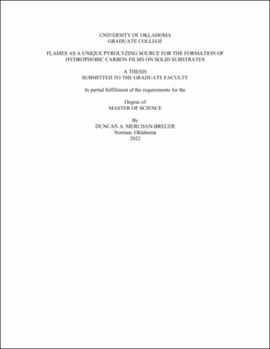| dc.description.abstract | In this work the rapid single-step flame synthesis of hydrophobic carbon layers (C-layers) on the surface of stainless-steel (SS) substrates is explored. A co-flow flame is used to generate a hydrophobic monolayer on the surface of the metal substrate upon its insertion into the reaction zone. Several flame parameters are explored including fuel type (biodiesel and methane), exposure time of the SS substrate in the flame medium, flame position of the substrate within the flame (inner-cone vs. outer-cone), and the percent of oxygen content in the oxidizer stream. The thickness and mass of the flame formed monolayer varied depending on the various flame parameters; however, there was no significant correlation between mass of the deposited C-layer and the layer’s hydrophobicity and/or uniformity. Flame structure played the most significant role in the hydrophobicity and uniformity of the deposited C-layers. It is hypothesized that a small “inner-cone” of the Canola Methyl Ester (CME) biodiesel flame along with a high soot propensity can result in an ideal medium to form uniform hydrophobic C-layers of unique hierarchical surface structure. This is supported by introducing SS substrates in methane/air flames formed using the same co-flow burner; this was further supported by experiments utilizing a CME/oxygen enriched-air flame to form C-layers.
It was found that a flame formed using a gaseous fuel (methane) over a vaporized liquid fuel, CME, has significant structural differences that enable vastly different deposition behavior of soot layers on the surface of solid substrates. Due to its larger pyrolysis zone (taller inner-cone), the CH4/air flame has a smaller region that supports uniform soot deposition of hydrophobic C-layers compared to the CME/air flame. When a solid substrate is placed within the pyrolysis zone (inner-cone) of a flame the resulting layer is non-uniform, hydrophilic, and consists of undeveloped soot. However, when the solid substrate is placed outside the pyrolysis zone, the deposited soot tends to be uniform and mature; ultimately creating a hydrophobic C-layer consisting of typical microscale interconnected “weblike” structures formed of spherical soot nanoparticles. The effect of oxygen content (35% and 50% O2) in the oxidizer stream for the formation of hydrophobic C-layers was also studied in this work. It was found that oxygen enrichment within the CME flame alters the structure of the flame, hence affecting the morphology of the formed C-layer. Under oxygen enrichment the central region of the deposited C-layer is composed of a weblike structure similar to those seen in the CME/air flames; however, this central region is bordered by a region of densely compacted soot that shows signs of significant thermal stress. At 35% O2 the thermal stress is expressed as multiple microscale cracks while at 50%O2 this border region shows much larger cracks and macroscale layer peeling. The hydrophobic property of the carbon deposits was quantified by measuring the contact angle of water droplets placed on the film’s surface. A water droplet drop test was conducted on the flame formed hydrophobic layers to study their wettability property. | en_US |
